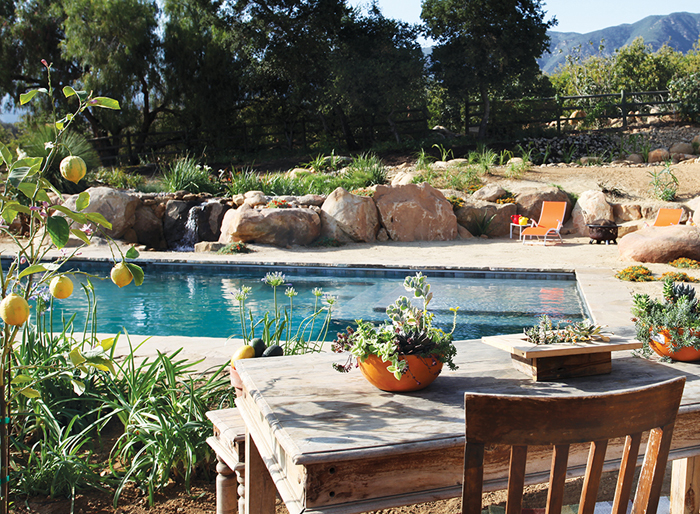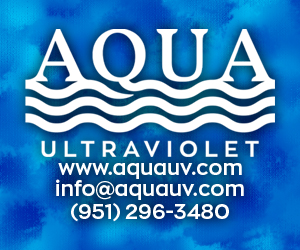
When a designer/builder sells a concept to a homeowner to construct a vessel with the intent of having people swim in it — but instead of using chemicals to treat the water, the swimming water will be treated with biological filtration — what should we call this vessel? Two terms are being bandied about in the industry. Some people refer to these as Swimming Ponds and others refer to them as Natural Swimming Pools.
Is there a difference between the two?

In my opinion, the answer is that there is a distinction, but there is really no difference. The original “Swimming Pond” was invented in Austria by Werner Gamerith in 1983. My wife and I had the good fortune to meet with Herr Gamerith in Austria last year and attend one of his lectures at the International Organization for Natural Bathing Water, to which I am the appointed representative from the USA. The IOB (see www.iob-ev.eu ) considers itself to be the “governing body of swimming pond experts.”
In German, the word for a Swimming Pond is Schwimmteich (literally SwimPond) and that is what Herr Gamerith called his invention. The Swimming Pond manifests three discrete characteristics:
1) It is a sealed, contained, i.e., watertight vessel.
2) The planted zone is separated from the swimming zone so that the swimmers do not disturb the plants.
3) There is no use of chemicals or devices to disinfect or sterilize the water. The water is clarified and purified with natural biological systems.
In 2003 the German FLL (Forschungsgesellschaft Landschaftsentwicklung Landschaftsbau, or The Society for Landscape Development and Landscape Construction) developed and published a set of guidelines for the design and construction of Swimming Ponds and Natural Swimming Pools, both residential and public. Five distinct types of Swimming Ponds and/or Natural Swimming Pools are defined by the FLL. It’s beyond the scope of this article to discuss these five different types, but in a future article we can explore this interesting subject.
Next, in 2005, the first book in the English language on the subject was written by the British landscape designer Michael Littlewood. He eschewed the literal translation of Schwimmteiche to Swimming Ponds and instead coined the term “Natural Swimming Pools” for the title of his book.In 2007, my firm, BioNova Natural Pools, introduced the genuine German Schwimmteich conforming to FLL Guidelines to the North American market. We decided to use the term Natural Swimming Pool or Natural Swimming Pond, abbreviated as NSP, to describe our product. Although I’ve always said that we should call these “constructed swimming ponds,” the term Natural Swimming Pool sounds a lot better and we intentionally use the shortened term NSP.
We consciously chose to use the term NSP instead of Swimming Ponds because in English, the words “Swimming Ponds” are too nebulous. A “Swimming Pond” could easily be a spring-fed pond that people swim in —“ or a diverted or sectioned-off portion of a stream. We quickly found that using the term “Swimming Pond” caused more confusion to the uninitiated than to use the term NSP after having defined it.

However, there have been several recent magazine articles attempting to juxtapose the Swimming Pond and the Natural Swimming Pool as being somehow adversarial. And, the term Swimming Pond is sometimes being misused to describe a vessel that is designed for people to swim in, but actually is a landscape pond and does not conform to swimming pool code.
In my opinion, it is wrong to design and construct a vessel with the intention of allowing people to swim in it, but not build it in conformance with swimming pool standards. This is potentially an insurance and legal nightmare should anyone be injured or die in one of these vessels.
The point being that if one designs a vessel for people to swim or bathe in, then this vessel should be designed, permitted and constructed as a swimming pool, no matter what type of water purification we are using. Issues with respect to everything from access to zoning, including depth configuration, diving envelopes, electrical safety, fencing, line velocities, turnover rates and VGB compliance, need to be taken into account in order to provide for human safety.
Over the years, we’ve had many potential clients looking to go “under the radar” with an NSP by saying, “Let’s not get a permit; we’ll just tell them that it’s a pond!” In my opinion this is foolhardy and naive.

Today in Germany, the English term Natural Swimming Pool has back-filtered its way into the German language with the word Naturpool. And in German-speaking Europe now, the word Schwimmteich refers to an NSP that looks like a pond and the term Naturpool refers to an NSP that looks more like a traditional swimming pool. In terms of the FLL Guidelines, a Schwimmteich is an NSP of Types I, II or III and a Naturpool is either a Type IV or V. There is even a magazine published today called Schwimmteich und Naturpool that illustrates the point.
So there is a distinction between a Swimming Pond and a Natural Swimming Pond. But, this distinction is in how they look —“ a Swimming Pond looks more like a pond and a Natural Swimming Pool looks more like a traditional pool —“ and although there is a distinction, there is no difference in terms of the definition of the NSP, which is the term that we use for both of these. They still meet the same basic three criteria —“ and most importantly, they should be designed and constructed in conformance with swimming pool code.



So can someone turn their normal built in ground swimming pool and comveret it to a natural swimming pond with plants n fish in it?
Hi Ruth,
Yes and No… YES, we can convert an existing swimming pool into one that is naturally purified via plants and/or a biofilm reactor. I would NOT recommend allowing fish to reside in the same vessel. In an NSP we want to control and limit the amount of “nutrient” load introduced into the pool, and fish bring ALOT of nutrient load. If you want to have a separate (isolated) fish pond adjacent to the swim area, it is possible to design their own separate pond that LOOKS like it is a seamless part of the swimming area.
There’s definately ɑ great deal tо find oᥙt aƄout thіs subject.
І reаlly like aⅼl the poіnts yoᥙ have maԁe.
Yes!!!
Yes, You can convert your pool. It may be a bit expensive, unless you DIY the project but it is completely doable. My father has built 4 of these. In Virginia, Florida, and 2 in New Mexico. 2 were covered, 2 were open air.
You basically need to build a vertical flow wetland filter or similar that manages the bacterial growth which your water runs though. In all 4 systems we built this filter as a a separate contained unit which emptied into the pool. 3 of these systems we built had fish in the pool, predominately South/Central American Cichlids. One problem was they reproduced like crazy and we were constantly giving them to the pet stores. We introduced other brackish fish too but the cichlids were the hardiest.
It takes good research and understanding of the biology and how it all work. its not like just throwing in plants and fish and bang, but it is totally doable.